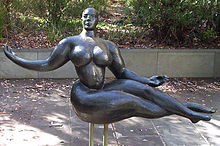Gaston Lachaise
Gaston Lachaise (born March 19, 1882 in Paris , † October 18, 1935 in New York City ) was a French-American sculptor .
Lachaise, who was active in the first third of the 20th century, is little known in Europe. He was fascinated by the French art scene at a young age. But love led him overseas, where, raised in the spirit of Art Nouveau , he became a pioneer of American modernism .
Life
Gaston Lachaise was born in Paris in 1882 as the son of a carpenter in high society. At the age of thirteen he began to occupy himself with sculpture. Three years later he was admitted to the École nationale supérieure des beaux-arts de Paris . There he learned the classical techniques of sculpture and soon achieved great success. His teachers were so enchanted by a bust depicting Lachaise's sister Ally that they sent him to the annual Salon des Artistes Français , the most important exhibition of visual arts of the time.
His artistic fate and his success seemed predetermined until he met the married Franco-Canadian Isabel Dutaud Nagle in Paris between 1901 and 1903. A love affair developed between the 23-year-old and the married woman ten years older than him. In his autobiography in 1928 Lachaise wrote of Isabel: “She has been my primary inspiration, the one that aroused visions in me and the leading influence that guided my powers. The whole time “the woman” and this person was an inseparable whole for me. ”
Lachaise broke off his studies and followed her to the USA. In order to be able to pay for his crossing, he worked for almost a year as an "unskilled worker" for the French glass artist René Lalique .
In the New World
His life as an assistant to artists continued in the New World. He bought a summer home and studio in Georgetown , Maine . For three years he was responsible for the details of memorials for the Civil War , in which the British sculptor Henry Hudson Kitson had specialized. In his free time he created a myriad of tiny, lush clay statues of Isabel, which he called "ma belle" (my beautiful).
breakthrough

His 1913 statuette "Naked Woman with Coat" attracted public attention. He subsequently received numerous commissioned works of all kinds; But he became known through the homage to his great love Isabel: torsos and sometimes larger than life statues with broad hips, large breasts, thin legs and small feet. In Lachaise's hands, her graceful figure became the body of an over-woman, the ideal of femininity and lust. Lachaise's art was inconceivably provocative for America at the time. The open representation of everyday, non- idealized nudity , the undisguised eroticism of his characters heated the minds.
His later works were marked by the glorification of female carnality, by the exaggeration of certain parts of the body; they are cast in bronze testimony to an obsession with female sexuality. In the course of his artistic career, his statues became less and less of Isabel's image; they evolved into images of the experience of fervent love for her. He was the first living artist whose work was exhibited in a retrospective at the Museum of Modern Art in New York in 1935. Shortly after the exhibition opened, he died completely unexpectedly.
In 1948, the designer couple Charles & Ray Eames designed a lounger, which Vitra still produces today, based on the form of his sculpture “Naked Woman with Coat” and named it “LA CHAISE” as an homage.
Web links
- biography
- Gaston Lachaise on art-memoires.com
| personal data | |
|---|---|
| SURNAME | Lachaise, Gaston |
| BRIEF DESCRIPTION | French-American sculptor |
| DATE OF BIRTH | March 19, 1882 |
| PLACE OF BIRTH | Paris |
| DATE OF DEATH | October 18, 1935 |
| Place of death | New York City |

